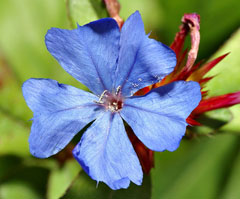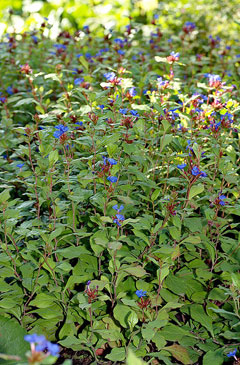 |
|
http://commons.wikimedia.org/wiki/User:Aka |
 |
| http://commons.wikimedia.org/wiki/User:Aka |
Translate this page:
Summary
Bloom Color: Blue.
Main Bloom Time: Early fall, Late summer, Mid fall. Form: Spreading or horizontal.
Physical Characteristics

 Ceratostigma plumbaginoides is a PERENNIAL growing to 0.4 m (1ft 4in) by 0.5 m (1ft 8in) at a fast rate.
Ceratostigma plumbaginoides is a PERENNIAL growing to 0.4 m (1ft 4in) by 0.5 m (1ft 8in) at a fast rate.
See above for USDA hardiness. It is hardy to UK zone 5. It is in flower from August to October. The species is hermaphrodite (has both male and female organs).
Suitable for: light (sandy) and medium (loamy) soils, prefers well-drained soil and can grow in nutritionally poor soil. Suitable pH: mildly acid, neutral and basic (mildly alkaline) soils. It cannot grow in the shade. It prefers dry or moist soil.
UK Hardiness Map
US Hardiness Map
Synonyms
Plant Habitats
Ground Cover;
Edible Uses
References More on Edible Uses
Medicinal Uses
Plants For A Future can not take any responsibility for any adverse effects from the use of plants. Always seek advice from a professional before using a plant medicinally.
None known
References More on Medicinal Uses
The Bookshop: Edible Plant Books
Our Latest books on Perennial Plants For Food Forests and Permaculture Gardens in paperback or digital formats.

Edible Tropical Plants
Food Forest Plants for Hotter Conditions: 250+ Plants For Tropical Food Forests & Permaculture Gardens.
More

Edible Temperate Plants
Plants for Your Food Forest: 500 Plants for Temperate Food Forests & Permaculture Gardens.
More

More Books
PFAF have eight books available in paperback and digital formats. Browse the shop for more information.
Shop Now
Other Uses
Soil stabilization
An excellent ground cover between shrubs, at the front of the border and in a sunny rock garden[200]. Plants are used to stabilize steep banks in warm climates[200].
Special Uses
Ground cover
References More on Other Uses
Cultivation details
Landscape Uses:Border, Container, Erosion control, Foundation, Ground cover, Massing, Rock garden, Specimen. Prefers a light moderately fertile and retentive soil with good drainage, though it tolerates poor dry soils[200]. Requires a sunny position[200]. The plant has an invasive root system and can spread freely when well suited[233]. Members of this genus are rarely if ever troubled by browsing deer[233]. Special Features:
Attractive foliage, Not North American native, Naturalizing, Extended bloom season in Zones 9A and above.
References Carbon Farming Information and Carbon Sequestration Information
Temperature Converter
Type a value in the Celsius field to convert the value to Fahrenheit:
Fahrenheit:
The PFAF Bookshop
Plants For A Future have a number of books available in paperback and digital form. Book titles include Edible Plants, Edible Perennials, Edible Trees,Edible Shrubs, Woodland Gardening, and Temperate Food Forest Plants. Our new book is Food Forest Plants For Hotter Conditions (Tropical and Sub-Tropical).
Shop Now
Plant Propagation
Seed - we have no details for this species but suggest sowing the seed in a greenhouse in the spring. When they are large enough to handle, prick the seedlings out into individual pots and grow them on in a greenhouse for at least their first winter. Plant them out into their permanent positions in late spring or early summer, after the last expected frosts. Division in the spring[200].
Other Names
If available other names are mentioned here
Native Range
TEMPERATE ASIA: China (Beijing Shi, Henan Sheng, Jiangsu Sheng, Shanxi Sheng, Zhejiang Sheng)
Weed Potential
Right plant wrong place. We are currently updating this section.
Please note that a plant may be invasive in one area but may not in your area so it's worth checking.
Conservation Status
IUCN Red List of Threatened Plants Status :

Growth: S = slow M = medium F = fast. Soil: L = light (sandy) M = medium H = heavy (clay). pH: A = acid N = neutral B = basic (alkaline). Shade: F = full shade S = semi-shade N = no shade. Moisture: D = dry M = Moist We = wet Wa = water.
Now available:
Food Forest Plants for Mediterranean Conditions
350+ Perennial Plants For Mediterranean and Drier Food Forests and Permaculture Gardens.
[Paperback and eBook]
This is the third in Plants For A Future's series of plant guides for food forests tailored to
specific climate zones. Following volumes on temperate and tropical ecosystems, this book focuses
on species suited to Mediterranean conditions—regions with hot, dry summers and cool, wet winters,
often facing the added challenge of climate change.
Read More
Expert comment
Author
Bunge.
Botanical References
200266
Links / References
For a list of references used on this page please go here
Readers comment
© 2010, Plants For A Future. Plants For A Future is a charitable company limited by guarantee, registered in England and Wales. Charity No. 1057719, Company No. 3204567.